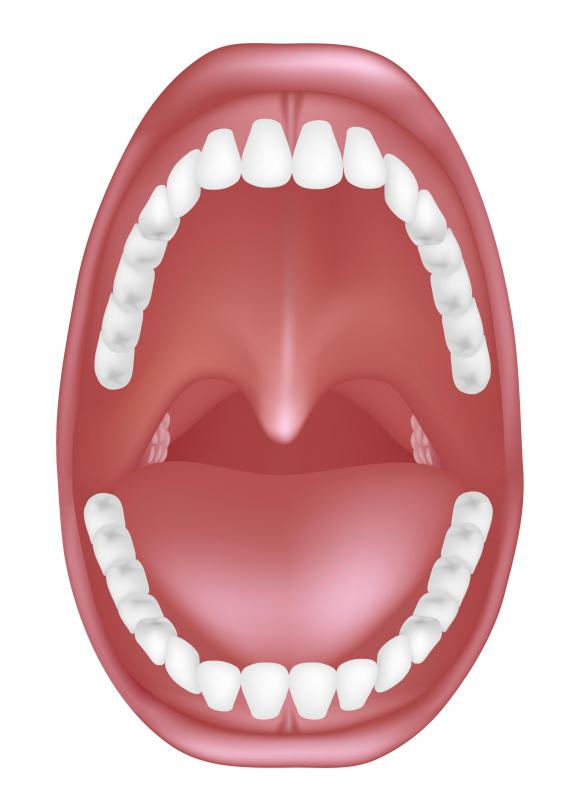At WiseGEEK, we're committed to delivering accurate, trustworthy information. Our expert-authored content is rigorously fact-checked and sourced from credible authorities. Discover how we uphold the highest standards in providing you with reliable knowledge.
What are the Maxillary Teeth?
Maxillary teeth are the teeth along the top of the human mouth. They rest along the upper jawbone, or maxilla, and have roots that extend into the upper jawbone resting near the maxillary sinuses. All together there are sixteen maxillary teeth, including the incisors, cuspids, bicuspids, and molars.
The incisors are located towards the front of the maxillary teeth. They include the right maxillary central incisor, right maxillary lateral incisor, left maxillary central incisor, and left maxillary lateral incisor. These four front teeth have sharp and flat edges to help cut through food.

Resting on either side of the right and left lateral incisor are the cuspids. These two teeth are referred to as the right maxillary cuspid and the left maxillary cuspid. The purpose of the cuspids are to help tear food apart. These teeth are often referred to as the canine teeth.
There are four bicuspids, two to the side of each cuspid. Bicuspids are labeled as the right maxillary 1st bicuspid, right maxillary 2nd bicuspid, left maxillary 1st bicuspid, and left maxillary 2nd bicuspid. These teeth have a broad surface and two cusps to help grind and bite food.

Located in the back of the mouth, the molars are the final section of maxillary teeth. All together there are three sets of molars, each with four or five cusps and rounded in shape. There are three right maxillary molars and three left maxillary molars. The first molar is closest to the front of the mouth and the largest of the three. Molars decrease in size from the first to the third molar and are used for grinding up food.

The third molars are different from the others. They are often the last to arrive, erupting between the ages of seventeen and twenty-one. Often referred to as wisdom teeth, surgery may be needed to remove them. Surgery becomes necessary because the wisdom teeth may come in at an angle, damaging surrounding teeth and leading to pain and swelling along the gum line.
For the maxillary teeth to function properly the opposing teeth, known as the mandibular teeth, must be taken into account. Mandibular teeth are the teeth along the mandible, the jawbone that forms the chin. The movement of teeth against each other is referred to as articulation. Working together, the human teeth provide a person with the ability to chew food and are an important first step in the digestive process.
AS FEATURED ON:
AS FEATURED ON:













Discussion Comments
I remember dissecting a frog in biology class and learning something interesting about their teeth. They don't have any teeth along the mandible, but they do have small maxillary teeth.
Also, they have vomerine teeth, which are teeth set into the roof of their mouths. My teacher said that these are just to help them get a grasp on their food while they chew it, probably to keep it from jumping around so that they can kill it more effectively.
@cloudel – You are one of the few people who actually get to keep their wisdom teeth. I had to have both my maxillary and mandibular wisdom teeth surgically removed, and so did almost everyone I know.
I couldn't eat solid food for a long time after the surgery. I remember waking up and feeling really sick. I vomited on the way home from the oral surgeon's office.
It's an intense surgery to recover from. Anything that affects my ability to eat really messes with my mood, so I was awful to be around for a few weeks!
@healthy4life – They also look a lot like the fangs on a dog or a wolf. Like you said, they are just less obvious and intimidating.
When I was a kid, I had to have the teeth right beside each cuspid removed, because they were crowding my other teeth, and they were actually growing in on top of each other. This made my cuspids look extra scary, because they were really emphasized. I'm really glad that I did have them removed at a young age, because now, I have plenty of room for my wisdom teeth.
The cuspids are the teeth that are often exaggerated in vampire costumes. What's funny is that they do look a little vampirish on their own.
They are pointed, though they are shorter and a little less sharp than the fake ones we wear at Halloween sometimes. We never really notice how much resemblance they bear to the fangs of fairytales.
Post your comments